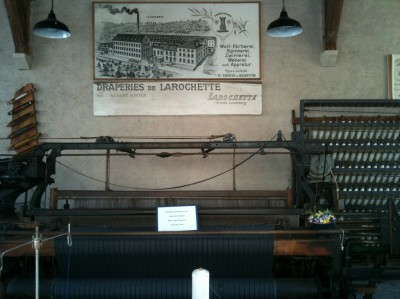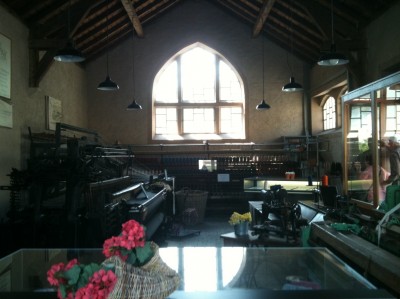An annexe of the former « Jhangli » train station hosts a small textile museum that can be seen through two large windows and that shows ancient textile machines (weaving loom, sewing machine…) originals from the former textile industries of the village.
The textile factories were part of the image of Larochette for over half a century. In the middle ages already, King John the Blind awarded the weavers the opportunity to use 4 weaving looms instead of only one as in most other towns. Originally, only the wool from the region or from the Ösling and the Eiffel was used. First, the wool was washed in large tanks then boiled in basins called “Bidden” with the addition of ammoniac collected in the urine of the villagers. For this very special collection, huge vats stood near the bridge, at the entrance of the village. Because of this peculiar custom the villagers were called “Biddesécher” or “Biddestöpp”.
The so cleaned wool was tainted and put on a “Schlompstack”, a piece of wood with a comb where it was roughed out. The result was weaved by hand to become cloth. Each piece of 25 cubits was washed again and hanged on a frame to dry. This heavy handicraft was done in small family workshops, the products were sold on regional markets or to the army after the Austrian Empress Maria-Theresia, in 1794, ordered that all cloth needed for the military must be bought from local production.
After the invention of machines, the villagers more and more specialised on just one part of the work. So, the small domestic industries became factories settled all along the rivers Ernz and Scheerbach, to use the power of the water. Besides, the wool now came from Belgium and France. The industrial era started with the invention of the steam machine. The factories grew and the loom became mechanic. The peak of weaving in Larochette was from 1870 to 1895 as the German Zollverein brought best opportunities. Later however, the local weavers were excluded from dealing with the military and an economical merger with Belgium had no success. Finally, only 3 factories survived before the European textile crisis although made them to close down between 1970 and 1985. So the more than 640 years old textile history of Larochette ended.
More details about the textile factories of Larochette under:
www.industrie.lu/stoffkleederfabriken.html (scroll down to Larochette)
Other factories of the village were:

